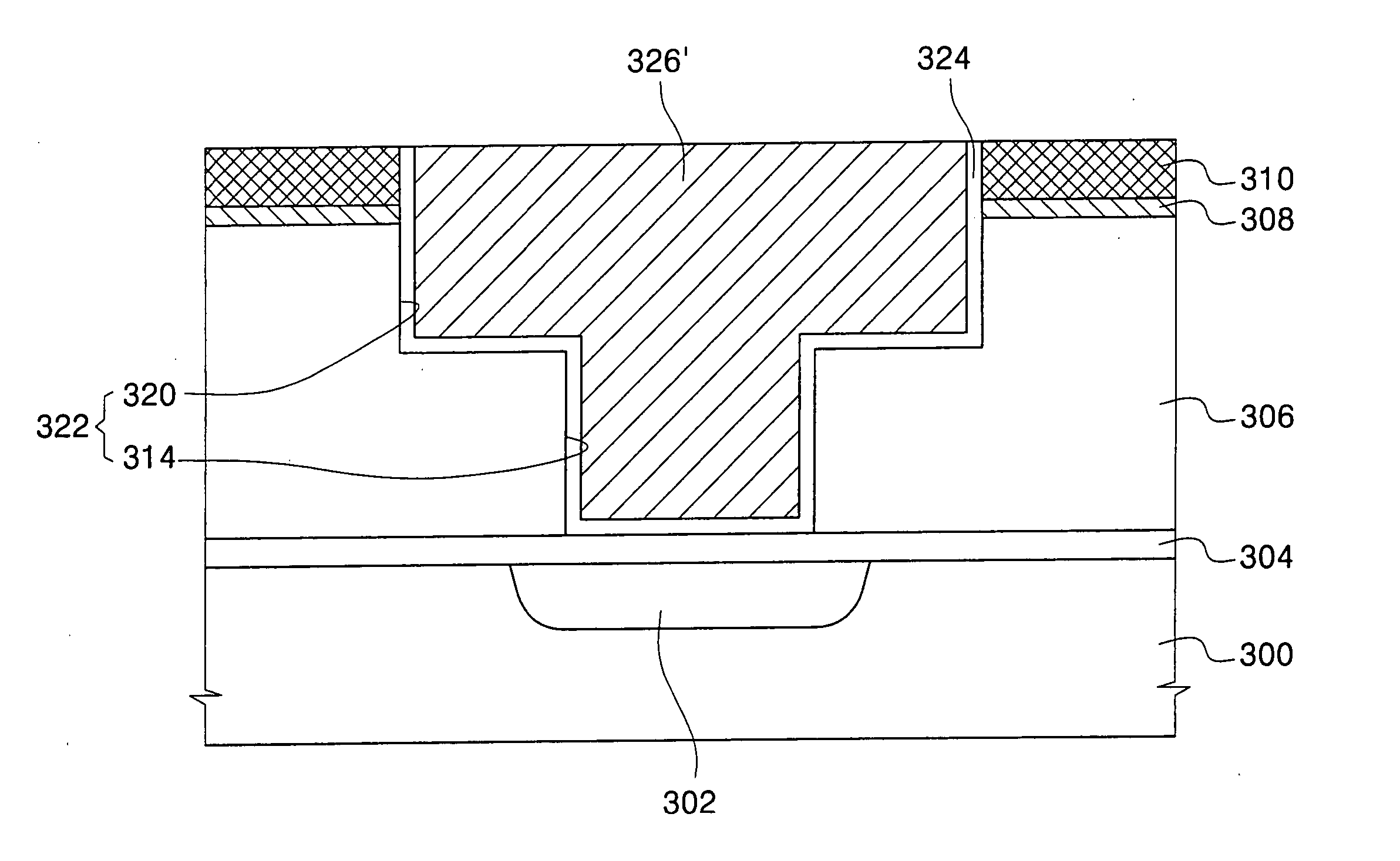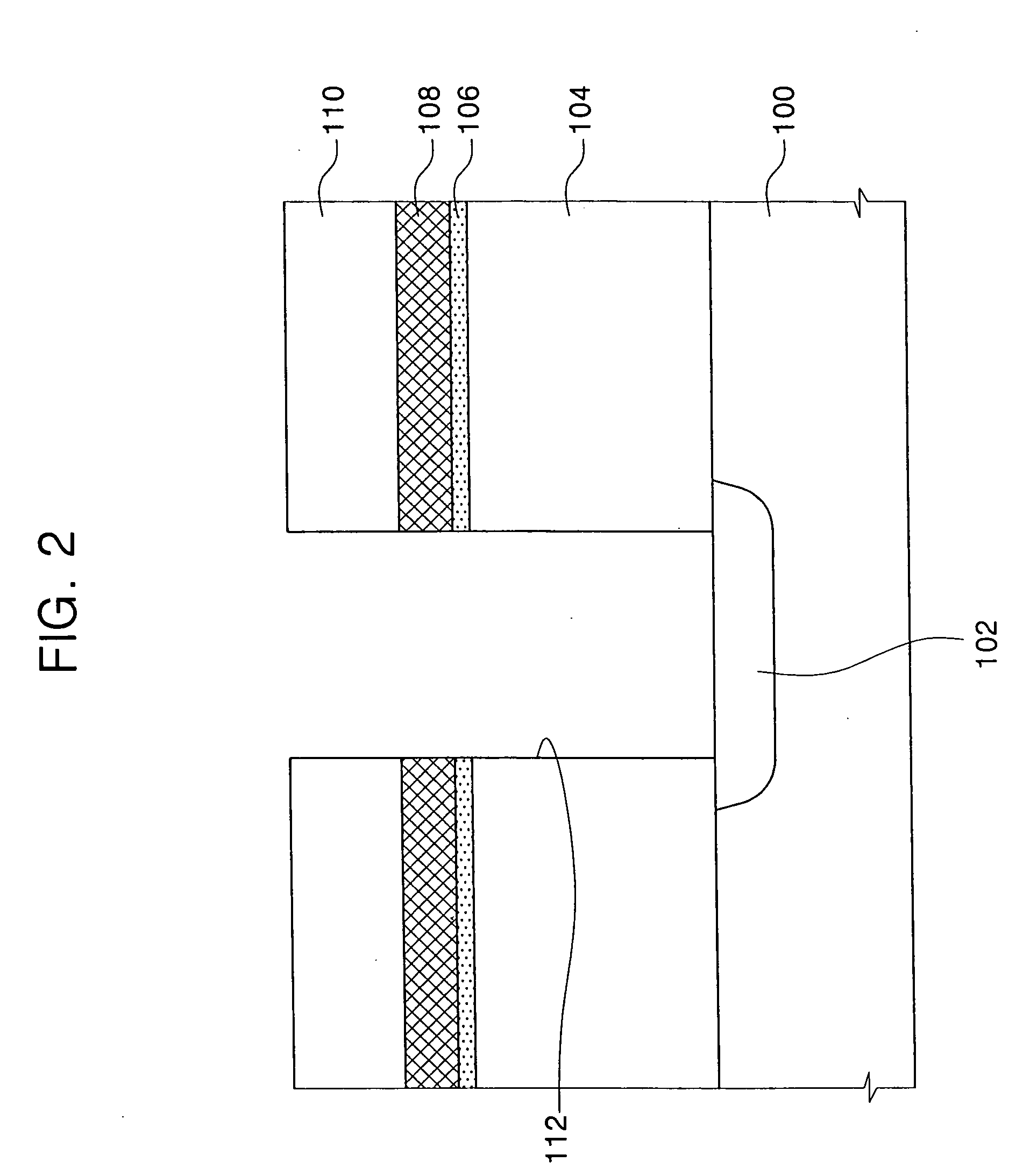Method for forming interconnection line in semiconductor device and interconnection line structure
a technology of interconnection lines and semiconductor devices, which is applied in the direction of basic electric elements, transportation and packaging, transportation items, etc., can solve the problems of resisting-capacitance delay, slowing electrical signals throughout the circuit, and slowing the total operational speed of the semiconductor devi
- Summary
- Abstract
- Description
- Claims
- Application Information
AI Technical Summary
Benefits of technology
Problems solved by technology
Method used
Image
Examples
first embodiment
[0019]FIG. 1 to FIG. 4 are cross-sectional views illustrating a method for forming an interconnection line of a semiconductor device in accordance with the present invention.
[0020] Referring to FIG. 1, an interlayer insulating layer 104 is formed on a semiconductor substrate 100. A conductive region 102 is formed in semiconductor substrate 100. Conductive region 102 is preferably an impurity diffusion region having P type or N type impurity ions implanted therein. Interlayer insulating layer 104 is formed of a low-k carbon-doped dielectric material. In the embodiments of the present invention, the low-k dielectric material has a dielectric constant lower than silicon oxide, which has a dielectric constant of about 4. Interlayer insulating layer 104 is preferably formed of an OSG layer of SiOC or SiOCH. For example, the low-k carbon-doped dielectric layer is an organic spin-on polymer layer such as SiLK™, which is available from Dow Chemical Co. When interlayer insulating layer 104 i...
second embodiment
[0029]FIG. 5 to FIG. 11 are cross-sectional views illustrating a method for forming an interconnection line of a semiconductor device in accordance with the present invention.
[0030] Referring to FIG. 5, an etch-stop layer 304 is formed on a semiconductor substrate 300. A conductive region 302 is formed in semiconductor substrate 300. Conductive region 302 is preferably an impurity diffusion region formed by implanting P type or N type impurity ions into semiconductor substrate 300. Etch-stop layer 304 is preferably formed of SiN, SIC, or SiCN. Etch-stop layer 304 prevents conductive region 302 from being exposed and damaged in a subsequent wet cleaning process or a subsequent anisotropic etching process to form a via hole. The same methods and materials may be applied as in the first embodiment to successively form an interlayer insulating layer 306 of low-k carbon-doped dielectric material, oxidation barrier layer 308, and oxide capping layer 310. Oxidation barrier layer 308 is pre...
third embodiment
[0043]FIG. 12 and FIG. 13 are cross-sectional views illustrating a method for forming an interconnection line of a semiconductor device in accordance with the present invention.
[0044] Referring to FIG. 12, a lower etch-stop layer 504, a first interlayer insulating layer 506, an upper etch-stop layer 508, and a second interlayer insulating layer 510 are successively formed on a semiconductor substrate 500 having a conductive region 502. Each of lower etch-stop layer 504 and upper etch-stop layer 508 is preferably SiN, SiC, or SiCN. First interlayer insulating layer 506 is preferably formed of low-k carbon-doped dielectric material as discussed in the first and second embodiments, but may be formed of a material that has a dielectric constant higher than that of the low-k carbon-doped dielectric material. In other words, first interlayer insulating layer 506 may be formed of a silicon oxide layer, a phosphor silicate glass (PSG) layer, a USG layer, an FSG layer, high density plasma (H...
PUM
 Login to View More
Login to View More Abstract
Description
Claims
Application Information
 Login to View More
Login to View More - R&D
- Intellectual Property
- Life Sciences
- Materials
- Tech Scout
- Unparalleled Data Quality
- Higher Quality Content
- 60% Fewer Hallucinations
Browse by: Latest US Patents, China's latest patents, Technical Efficacy Thesaurus, Application Domain, Technology Topic, Popular Technical Reports.
© 2025 PatSnap. All rights reserved.Legal|Privacy policy|Modern Slavery Act Transparency Statement|Sitemap|About US| Contact US: help@patsnap.com



